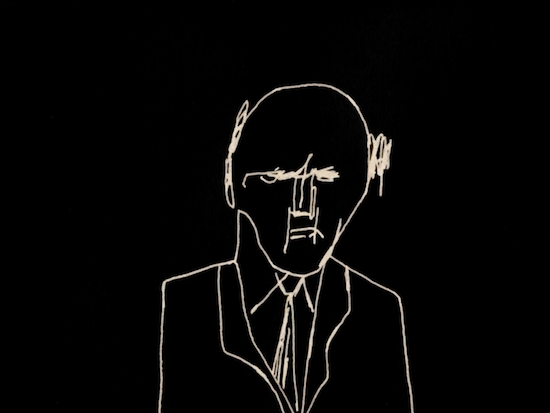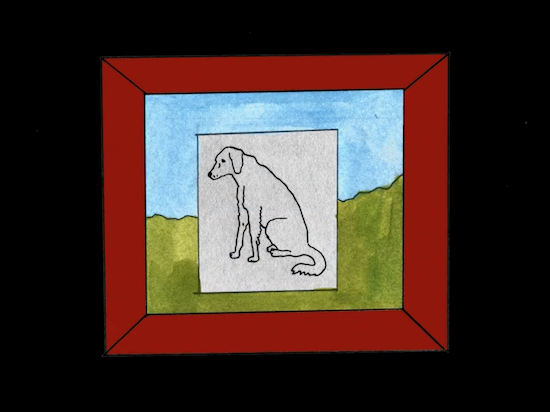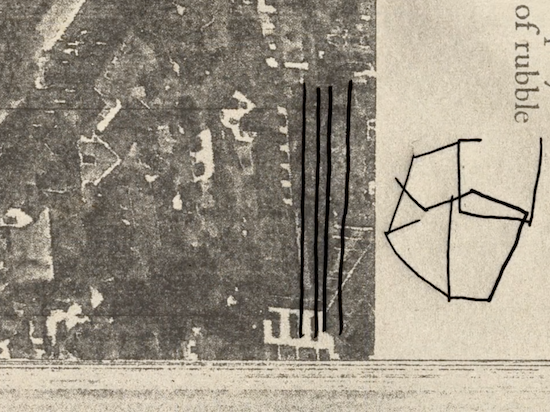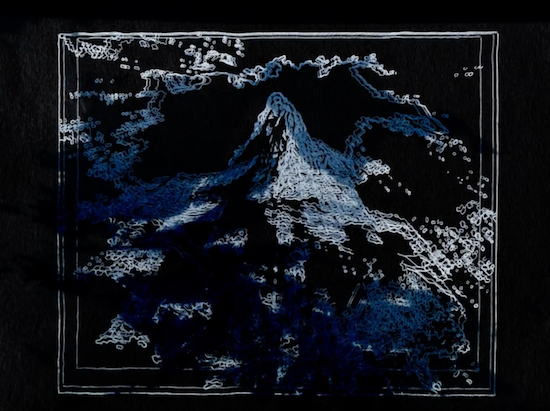“I’m a bit suspicious of people who go on about words all the time,” says musician-poet-multihyphenate Supreme Vagabond Craftsman (SVC), delivering snippets of spoken word in a droll monotone over a soundtrack of improvised synth and distorted cassettes, free ranging squeaks and squarks mixing over a scratchy fuzz of scene-setting pre-recorded sound. One of many similar musings – one-line thoughts situated somewhere between profound aphorism and dim-witted interior monologue – it’s a particularly funny line in part because it arrives in the middle of a performance that contains, well, a lot of words.
Spluttering out sentences in a near-continual stream of consciousness, SVC’s prose style can be best described as consisting of seemingly nonsensical non sequiturs that collectively describe a worldview. Consisting largely of apparently unconnected and often incomprehensible nonsense-rhyme that verges from the very strange (“radio brain smurfs”) to the entirely ordinary (“there was a Pizza Express here”), these words are bound together by an outlook, an overarching grumpiness that connects it all.
The perspective offered is a particular style of disgruntled Englishness, implacable but immediately recognisable, and somewhat culturally specific. Imaginatively annoyed, SVC’s prose-poetry sounds like the inside of the brain of a businessman staring out of a commuter train, his eyes looking at the land in front of him but his mind far away. His suit soaked in rain and his briefcase tattered, his hairline retreating and his facial expression stuck in a permanent grimace, he travels cyclically from a job he hates to a family he feels distant from. Yet when gazing out onto the grey horizons that unfold in front of him, something better seems possible, or at least, something different.
As his verbal tirade continues, each utterance from SVC starts to seem less like random outbursts and more like a channeling of something, a man ushering in his unconscious and letting it take centre stage. Deliberately obtuse both in terms of content (strange descriptions of ordinary scenes, or ordinary descriptions of strange ones), and construction (words placed in sequences that they ordinarily wouldn’t be, sounds slammed together so their jagged edges are exposed, language used as a phonetic instrument as much as a means of communicating an idea), his is a strangeness that is not just weird, but seemingly weird in direct resistance to the ordinary. Each spoken passage starts to seem like an example of the idea of freedom as something that exists only in the mind, or that pleasure can be found in entertaining idle thoughts or by escaping into the imagination as much as in action or activity.

This effect is only furthered by the animations from Edwin Rostron that accompany SVC’s performance, which are similarly associative and positioned in a similar emotional space. A collaborative project, Phased Return sees Rostron, a teacher, creator and curator of experimental animation, compiling and creating visual content in response to the propositions offered by SVC’s texts and sounds, presenting images that are not specific representations of the situations and ideas described but instead attempt to exist visually in the same psychological space, to explore what it might mean to draw, design, collage or photograph this same subconscious, to create a mood to match. Presented as it was in London’s Close-Up Centre – a 40 seat independent cinema and an intimate stage for such an experience – this meant SVC plus equipment (several synthesisers, a few cassette players and a microphone) sat adjacent to the screen on which Rostron’s animations were projected, a visually varied and often astounding sixty minute sequence that SVC was not able to see.
Synchronicity then – unlike with many similar AV performances – was not necessarily the intention. Yet the two elements proved to be far from unrelated, SVC’s oddball verbal digressions and synth screechings matched tonally in the mood of Rostron’s animated collages, a mix of dingy, dusky sequences—bleary, dark and somewhat pleasingly grim – with much more vibrant material: odd sunlight amongst dark clouds, small dream colours breaking the real world grey.

Another connecting factor was the presence of texture, layered through sounds in SVC’s music, a mixture of simple electronic melodies, 8-bit type computer bleeps and bloops, more wirey, droney synth sounding calls, and a more persistent, familiar tape fuzz laced ambient base; and equally in Rostron’s images that flickered alongside it. Whether in the scratchy, sketchy and grain laden animations, the various collected and scanned images and cuttings, each equally dusty, dirty and seemingly timeworn, or in rough, warped mini-DV videos, everything was granular – the materiality of it all emphasised and lent a tactility and a depth. Each image looks less like something created than something found, and collectively the hour of combined material feels accumulatively something like a treasure chest or a time capsule, Rostron’s curator mindset matching his collector’s approach, compounding and layering found and created elements alongside material from his own archive and that of others to make a peculiar museum of objects.
Non-linear and collagist in form, it is hard to draw a through line between the images, and they are not expected to relate to the words and sounds that are heard over them. Opening over SVC’s mumbly tape drone, the first image of Phased Return sees lines tracing the outline of a face, chalky white lines gyrating starkly against a sketchy black background. Strikingly minimalist, it sets the scene and the tone. Next, a series of black and white photographs flicker by, static landscapes devoid of any human trace, before further chalk faces are seen, the line-work of which collapse into shapeless forms.

Faces prove to be a motif, appearing most notably in the form of a series of blank faced bureaucrats that appear often, but also in the form of stone heads, also somewhat gormless in look. Also omnipresent is the landscape, seen as the sea seen through portholes, or in mountains or expanses of field, or as townscapes and cathedrals. Sepia toned owls rotate their heads in unison, wispy trees flutter as abstract line formations dance are drawn over them, dogs sit stationary as boxes collapse around them. SVC mumbles on, images move by in sequence, and before long, through the rhythm, the sequencing, and the consistency of the style, a mood is imbued.
Long periods of the performance involve visual abstraction – geometric forms that morph and mutate, lines that form patterns that dissipate and form anew, shapes that shift and change in real time, and grids that expand and evolve. These, though the simplest element, are maybe the most captivating, demonstrating the mutability and freeness for which animation is most suited, as well as the appeal of being able to see that is it being done truly independently. There is a thrill in sensing the unseen hand that lies behind every scribbled line and the love that is present there, the levels of work that goes into producing an hour of something that takes many thousands more to make. In these moments, the union of all things was most apparent. SVC’s sounds, a host of bleeps, warps and warbles that eventually form meandering music, and his continual verbal digressions, itself becoming a sort of monotonal music, mixes in with Rostron’s visual explorations, years of curiosity and collection intermingled with drawn experiments that are continuously mobile and similarly searching, to make something simultaneously disconnected and not. No clear connection is needed when a mood is met, two individuals independently mapping a shared subconscious, two strange minds meeting and making a new world, much like ours, but also not, recognisable but also off.


